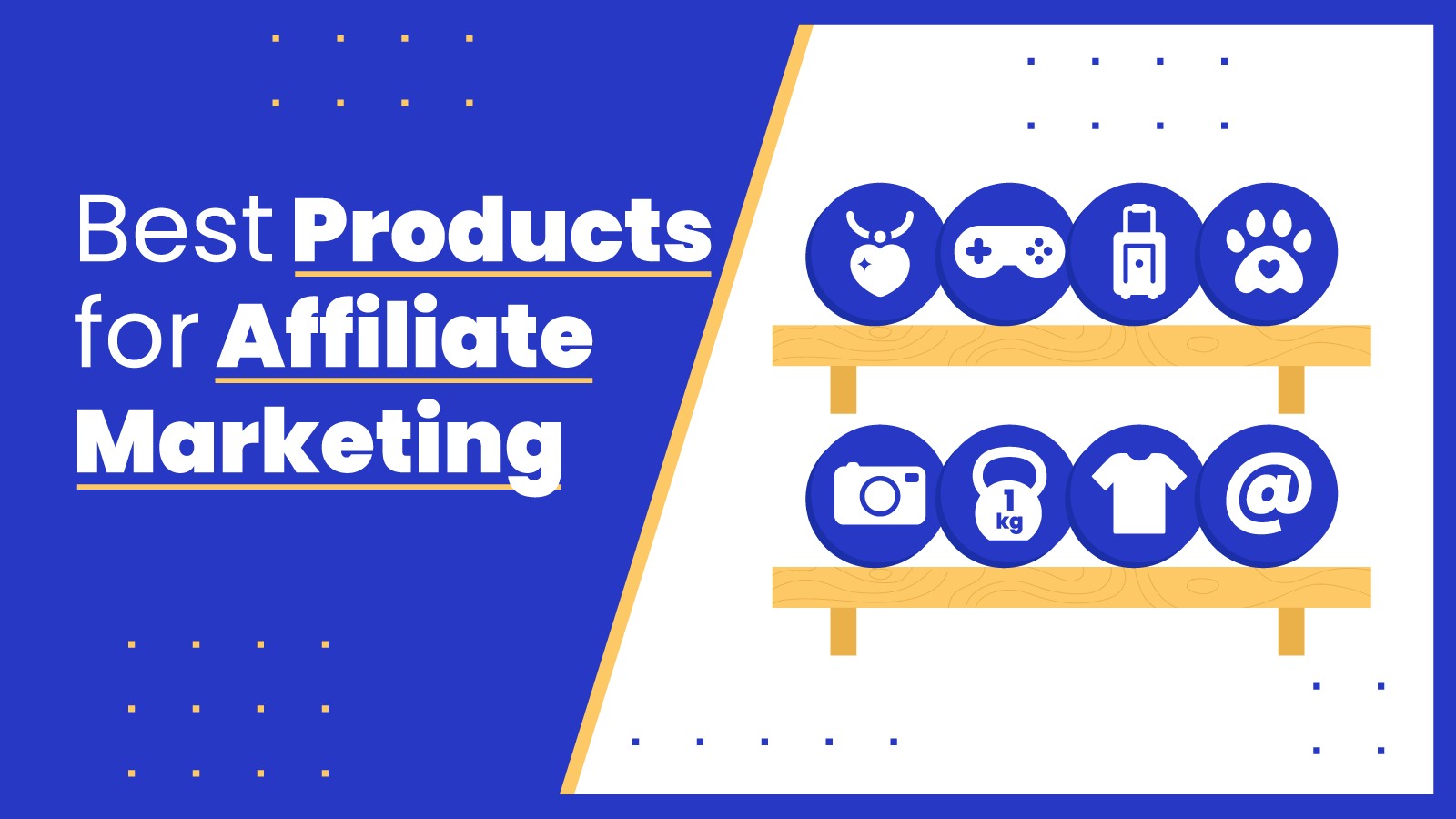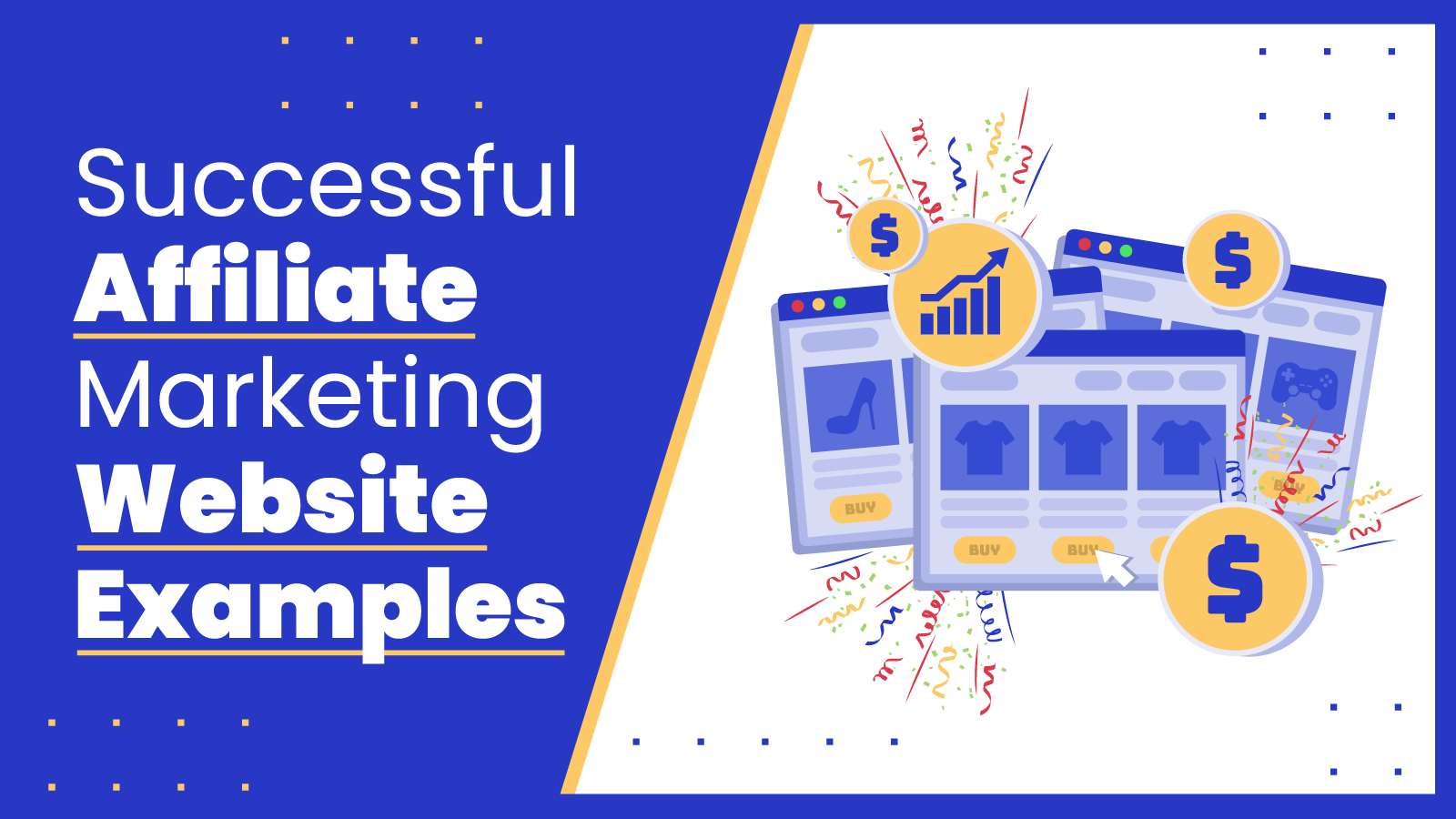Most affiliate marketers view Facebook as the best place to focus their efforts.
But is it really?
Sure, it has almost 3 billion active users.
But where does your ideal demographic hang out?
Because if you’re targeting 18 – 30-year-olds, 57% of them almost exclusively use Instagram.
47% of boomers also hang out there.
And it has 1 billion active users, so it’s not exactly a social media graveyard.
Instagram affiliate marketing might just be worth a second look if you want a new traffic source to tap into.
So let’s take a look at how you might go about becoming an affiliate influencer.
What is Instagram affiliate marketing?
Instagram affiliate marketing is when you take the key principle of affiliate marketing – earning commission through referrals – and apply it to one of the biggest social networks on the planet. The difference is that you do this using pictures instead of text.
It’s one of the most popular forms of affiliate marketing. 61.4% of affiliate marketers use Instagram to promote products and drive traffic, according to our affiliate marketing statistics page.
Something else that makes Instagram different is that it’s the preferred platform for the majority of social media influencers.
Then you need to factor in that around 70% of Millennials value the opinion of influencers more than anyone else.
Influencers have huge clout when it comes to brand awareness.
So your potential customers actually use Instagram to find reviews of products they want to buy.
That places it in a unique position among all the other social media platforms.
Which is why it’s wise for an affiliate marketer to test working with this social platform.
You might not like social media.
I don’t.
But that doesn’t mean you shouldn’t profit from it.
Or at least make it another spoke in your affiliate marketing strategy.
Instagram is about images though so you won’t be able to rely on your typical affiliate marketing tactics.
Instead, you’ll have to grab a visitor’s attention with photos and images.
And somehow fit a pre-sell for those products into the same tiny screen area.
By the way, now is probably a good time to accept that you’re going to become an Instagram influencer in your own right.
That means I’ll use the terms affiliate marketer and Instagram influencer interchangeably throughout this article.
Otherwise, it’s just going to get confusing really, really quickly.
So prepare for your 15 minutes of online fame.
Now let’s look at how you go about setting yourself up in the Instagram affiliate marketing game.
How to get started with affiliate marketing on Instagram
Before you set off on your journey to dominate the world of Instagram influencer marketing you’ll need an affiliate program to promote.
You can do that by searching for the affiliate program for a brand or product you like.
This can be as simple as dropping the company in question an email, introducing yourself, and that you’d like to promote their products or service.
Or you can sign up with some affiliate networks instead.
That way you can choose from literally hundreds of different advertisers and brands.
The bigger networks recognize that social influencers can drive a lot of traffic and interest to their advertisers.
Which is why some of them have a separate affiliate portal for those involved in influencer marketing.
Amazon’s Influencer Program is one of the best examples of how to approach this.

It’s basically the same as the standard Amazon affiliate program, paying you a commission for referrals sent through your affiliate link.
But you get a dedicated page where you can share your recommended products with your Instagram followers.
So, you don’t need to set up an external blog for affiliate marketing purposes if you don’t want to.
That type of offer makes the average influencer sit up and pay attention.
Awin doesn’t give you a dedicated landing page but they do have a separate page for future influencers.
And they do actively work with Instagram and other social media influencers.
The CJ affiliate network is also happy to work with social influencers, so they’re worth checking out.
And the final affiliate network that gets a mention is Rakuten Advertising.
They’re a huge e-commerce company, so influencer marketing is second nature to them.
Affiliates will be familiar with these networks if they’re already active in the game.
But if not these networks are a good place for influencers to search for programs to promote.
Note: Awin is the only network where there’s a fee to become an affiliate ($5) – but they refund that with your first commission payment.
Another way to find Instagram affiliate programs is to simply search for Instagram influencers already operating in your niche.
Let’s see what we find when we use a topic that’s grown in popularity over the last few years – prepping.
My research eventually brought me to a page called Everyday Carry:
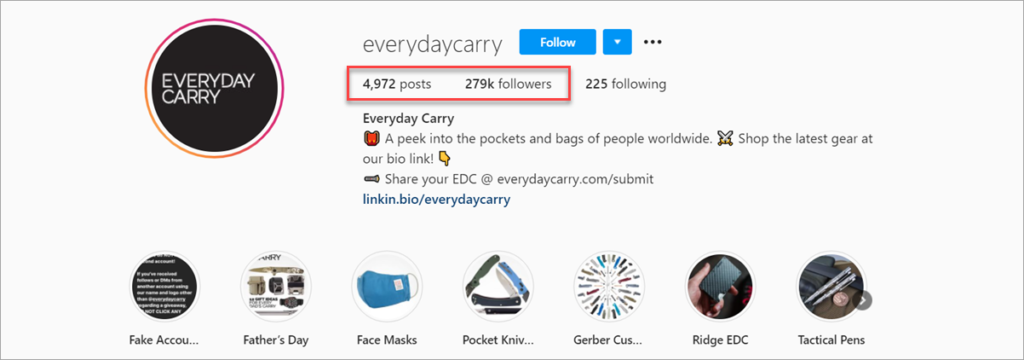
For those of you who don’t know, an EDC (Everyday Carry) is the small survival kit you carry around with you every day.
They’ve got 279k followers.
That isn’t huge for Instagram when compared to celebrities with 20 million followers.
But for an affiliate marketer, this is a huge focused audience to be monetized with a variety of products or services.
You might have noticed they have ‘Instagram Stories’ (categories) listed above their Instagram posts.
And when you tap on any of these you’ll be presented with a gallery of images related to that “Story”.
In this case, I tapped on “Survival pens” and swiped up.
Ker-ching.
Not only have I identified a niche for my influencer marketing plans, but I now also know what affiliate program they use.
But how do you actually promote your affiliate offers on Instagram?
I knew you were going to ask that question next.
👉 Read more: How to Become an Amazon Influencer
How to promote affiliate offers on Instagram
Adding affiliate links to images or text on a WordPress or other blog is easy.
It takes minutes to learn how to link out to products.
But how do you add affiliate links to your Instagram posts or content?
It’s actually far easier than you think.
Swipe-up in Instagram Stories
So, if we take a quick step back to the tactical pens on the Instagram page for Everyday Carry.
When you tap on that ‘Story’ you’re brought to a gallery of tactical pens.

And when I swipe up to ‘See More’ I’m brought to the Everyday Carry blog.
The external blog post contains reviews of the best tactical pens – each containing a link to Amazon where I can purchase my tactical pen of choice.
And if I just happen to buy one of these products, the blog owner will earn a commission.
From traffic sent from their Instagram account to their blog posts.
Free of charge.
This is Instagram affiliate marketing in motion.
But you do need a business account with at least 10,000 followers to be able to use the swipe-up link feature.
An Instagram Business account is free though and comes with other perks like marketing data insights.
So make a note of that for reference.
In your image description
You can also just add your affiliate link to your image description.
This isn’t something you see very often, mainly because you can’t actually tap on the link and go straight to the product page.
So that makes it kinda clunky for your visitors.
This is how one Star Wars collectibles affiliate marketer links out to products:

That’s a link directly to a page on eBay listing Tie Fighters for sale.
As I said, the downside here is that the link isn’t clickable.
So your followers would have to copy and paste the link into their browser.
Star Wars fans might be happy to do that…but most normies won’t.
In your Instagram bio
The “…link in the bio” approach works really well if your influencer marketing plan is to only promote one affiliate program at a time.
Or you just want to send followers to your blog.
Here’s an example from the Everyday Carry page:

They use a service called Linkin.bio by Later.com.
This turns your Instagram feed into a landing page populated with clickable images:

Every single image can then link out to your blog.
You can use this service (it has free and paid options) or simply place a short link to an affiliate offer in your bio instead.
The only snag is that you can only have one link in your bio at any one time.
So you’d either have to rotate through different affiliate marketing programs.
Or use something like Linkin.bio instead.
Coupon codes
These are becoming increasingly popular with Instagram influencers, and by association, affiliate marketers.
This is probably down to the fact that they can be given a shout out in a promo post.
But that’s all the marketing work the influencer has to do.
All the affiliate tracking stuff – if your followers buy anything – is handled by the advertiser.
You could mention a different coupon code every day if you wanted to.
And without ever having to update the link in your bio or mess around with landing pages.
Legal stuff
Using Instagram doesn’t mean you can avoid using the dreaded affiliate marketing income disclaimer.
But you can keep it relatively straightforward by simply including the #ad or #spon tags in any Instagram post that might generate affiliate revenue.
Does everyone do this?
No.
But certain affiliate networks will shut your account down if you forget to add your affiliate disclaimer.
So you’re better off adding it – just to make sure you’re covered.
👉 Read more: How to Promote Affiliate Links
Revenue and growth tips
Now that we’ve covered the foundational stuff let’s look at how some best practices when it comes to making the most of your Instagram affiliate marketing.
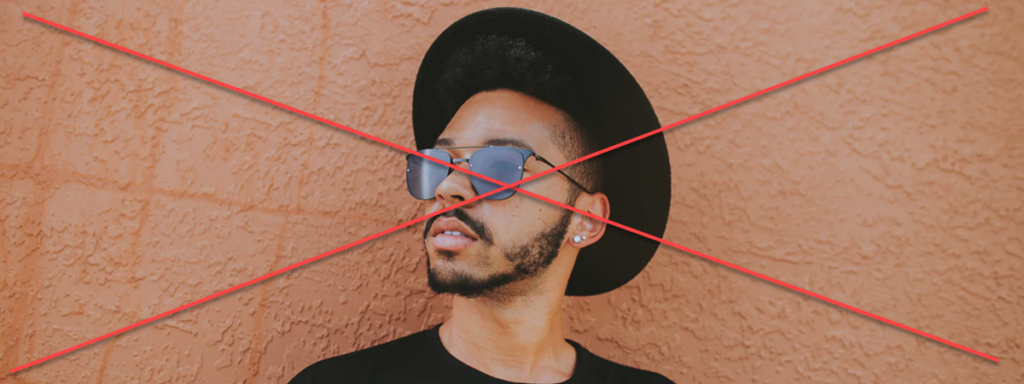
Don’t use stock photos
Instagram was originally a platform for hipsters to share their retro-inspired photos with their friends.
Its audience might have shifted towards Millennials and Gen Z’s but the core idea is the same – sharing photographs.
Memes and other images can be effective in small doses.
But you won’t get the same engagement rate with your followers.
That’s also why you should make sure to never use stock photos.
Ig’ers can spot them a mile away.
Actually, most people can.
So you’ll simultaneously ruin your credibility with both groups of followers.
Engagement
And while we’re on the subject of engagement…you might be wondering how Instagram compares to Facebook on that marketing metric?
There’s no comparison.
Depending on what study you read, content posted to Instagram gets 3x – 6x the engagement rate of the same content posted to Facebook instead.
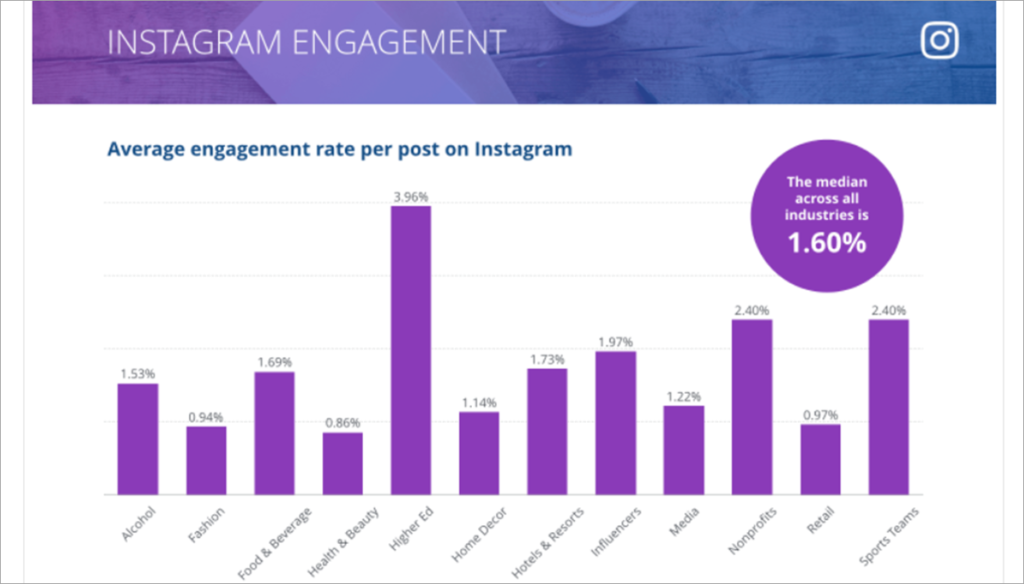
Rival IQ’s social media benchmark report is well worth a read if you want a deep dive into Instagram marketing metrics.
It puts a lot of assumptions to bed e.g. Facebook has better engagement than Instagram.
Don’t buy followers
It’s very tempting to give your Instagram profile a boost by buying a few thousand followers.
After all, isn’t that how affiliate marketing on social media works?
That’s not a good assumption to make.
Mainly because when affiliate program managers notice that you have 50 posts and 50,000 followers…it’s going to take them 5 seconds to figure out what you did.
And then instantly decline your application because your next “hack” is to send them fraudulent clicks.
You’ve been warned.
There are smarter and easier ways to gain followers on Instagram.
Like the next tip on our list.
Sponsored posts
It might sound clichéd as hell, but run a handful of paid-for posts to get your name out there when you first get started.
And then boost that by running some kind of competition or giveaway.
Social media addicts love free stuff.
They’re also likely to share your story with their friends – there’s still social clout associated with being “first”.
An added bonus is that these posts are obviously promotional in nature.
So you can add your affiliate link directly to them.
It’s basically the same idea as using a ‘Boosted Post’ on Facebook.
Make use of video
Love it or loathe it, TikTok has made short vertical videos popular again.
So much so that YouTube is doing their best to umm…imitate it with “YouTube Shorts”.
Yes, this means really putting yourself out there in public.
But the engagement rate with sub-1 minute videos right now is ridiculous.
Don’t spam
If you find yourself tempted to pitch a new product every day, then don’t.
Spamming your audience with random offers won’t achieve anything except reducing your follower count.
There are smarter ways to make money online with influencer marketing than just spamming your feed.

Avoid social media drama
You are on Instagram to make money.
Not to get caught up in influencer drama.
Something that would be an absolute nothing burger in real life can stick to you like glue online.
And influencers (and their followers) tend to dog-pile in negative hype situations.
So, the best practice is to simply avoid drama – it won’t benefit your affiliate marketing except negatively.
Less can be more
You do not need to have 1 million followers to make decent money with Instagram.
In fact, the more focused your niche is, the smaller your follower audience will be.
And that’s fine.
You’re far better off having 10,000 fully engaged followers than 100,000 random followers who only stay subscribed out of curiosity.
Better engagement means higher conversion rates.
That’s how micro-influencers operate – under the radar.
Socialize
Instagram is obviously a social network.
So take part in that by following other related accounts that are not direct competitors.
And try to interact when they post on Instagram.
A quick comment is enough, or share it when you think your own followers would dig it.
Leaving a few comments each day for the first few months should be enough to get the ball rolling.
Basically, you can’t just take the “…build it and they will come” approach – you have to put at least some effort into creating relationships with other creators on the platform.
Limit your tags
The temptation is to cram as many tags as possible into each post.
But that’s actually counterproductive to your Instagram affiliate marketing efforts.
Remember, these are how people find your content when they search Instagram.
A travel blogger should only use tags related to travel for example.
A photographer should only use tags related to photography.
You get the idea.
Here’s a post from Everyday Carry to highlight this:
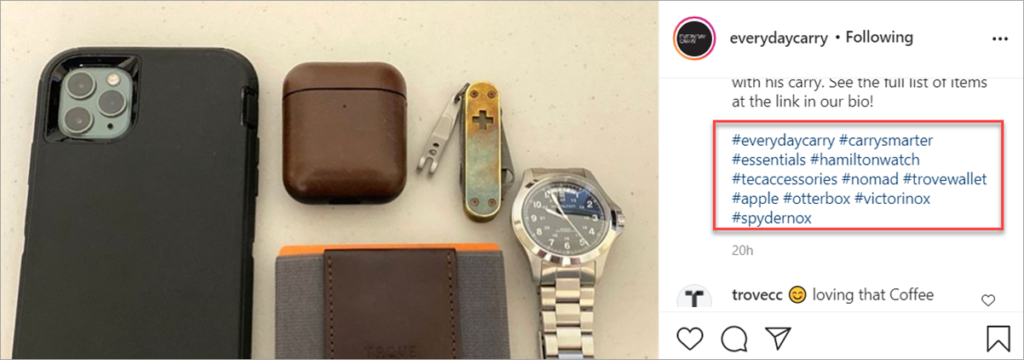
Each tag relates to an item in the image, the niche, the profile they’re posted to or a specific brand name.
But you won’t find any “#SafeFromZombies” or “#ApocalypseNow’ tags added for good measure.
Your tags aren’t just window dressing.
So make good use of a small number of tightly focused tags in your content.
Anything more than that is just fluff or your ego speaking.
Or both.
Examples of affiliate marketing on Instagram
Instagram is the home and birthplace of the social influencer.
But the truth is that social influencers really aren’t anything other than extroverted affiliate marketers.
The rest of us regular affiliates lurk in the shadows, publishing content, acquiring links, and arguing in Facebook groups.
Meanwhile, IGers are out there and are busy getting eyeballs on their images.
And in all kinds of obscure niches.
Like IBS (Irritable Bowel Syndrome):
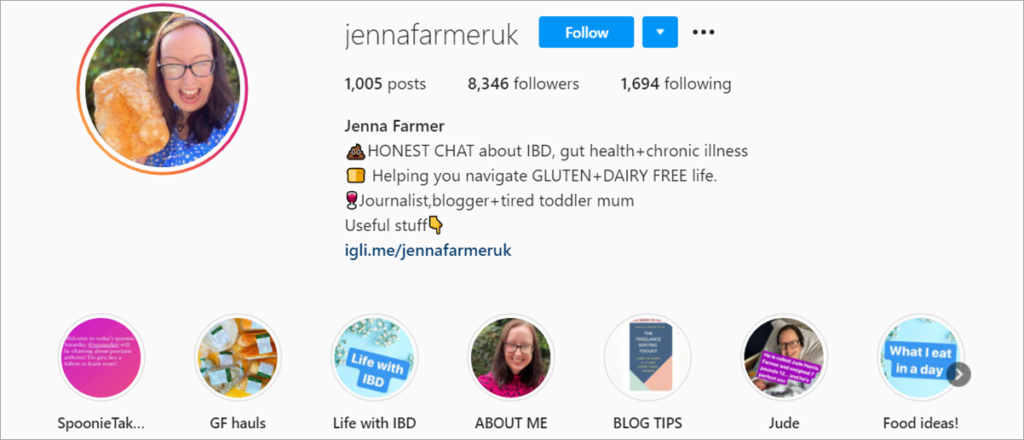
Jenna reviews products and foods beneficial to anyone suffering from IBS/IBD.
She doesn’t have a huge following, but she does actively monetize it.
And then at the opposite end of the affiliate spectrum we have a page dedicated to Funko Pops:
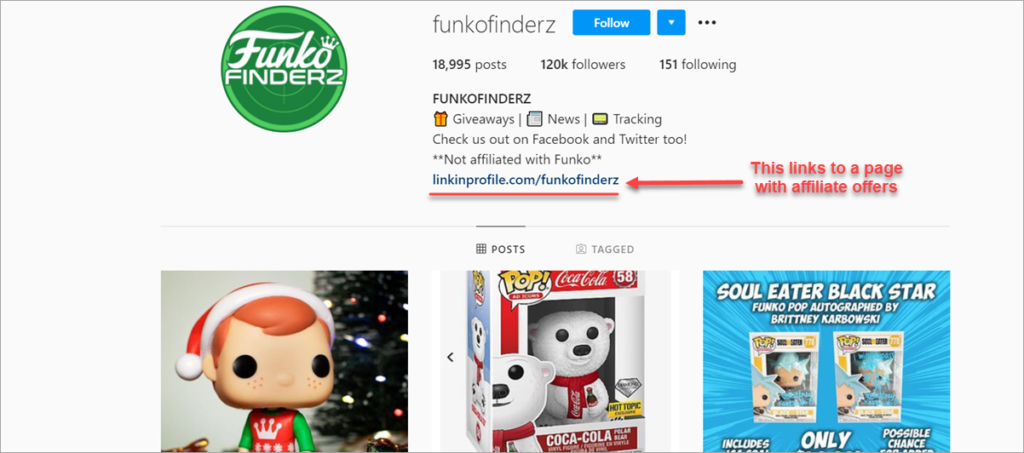
With a staggering 120k followers.
That makes sense though because this is a really narrow niche to be in.
But one with lots of “ravings” fans who are always on the lookout for new Funkos to buy.
Like Lego Funko figures:

These are here to show you that Instagram affiliate marketing isn’t only about makeup, travel or tech gadgets.
It’s far more interesting than that.
Pros and cons of Affiliate marketing on Instagram
So let’s get down to the nitty gritty here and look at the advantages and disadvantages of Instagram affiliate marketing.
Pros
- You get instant access to an audience of 1 billion people
- Creating posts is easy
- Instagram has far higher engagement rates than Facebook.
- A lot of Millennials refer to Instagram before making a purchase
- Instagram is the dominant network for the 18 – 35 demographic
- You can direct Instagram traffic to your external blog
- Sponsored posts can be targeted to a very specific audience
- You get to work with images instead of text – ideal if English is not your first language
- It’s a great way to showcase products i.e. it’s image-based
Cons
- The majority of people aged 49 or over don’t use Instagram
- It doesn’t work for every niche – sometimes Facebook actually is a better option
- Sponsored costs can be prohibitively expensive
- The popularity of any social network is transitory i.e. they all fade in time
Should you start affiliate marketing on Instagram?
Being able to offer you a simple “Yes” on whether or not you should dive into Instagram affiliate marketing here would be ideal.
But it’s a bit more nuanced than that.
Can you make money on Instagram?
The answer here is, “Yes”.
As a marketing platform, Instagram can work really well in many niches…but not every niche.
So, if you can’t find Instagram affiliate marketers in your niche, there’s a very good reason for that.
Basically, they tried and died on that social hill.
So that’s the “Maybe” to add to the equation.
With that said the engagement rates on Instagram are so stupidly high you’d be silly not to dip your toe into the water at least.
But understand that you should not build your entire affiliate business on an Instagram page.
It should only ever be part of a broader marketing strategy.
One that’s focused on building the asset you do own – your website.
